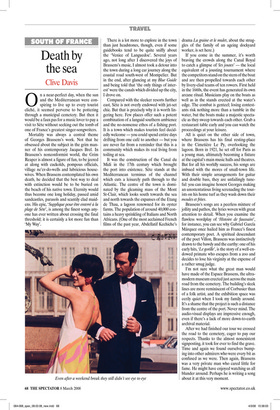Death by the sea
Clive Davis
On a near-perfect day, when the sun and the Mediterranean were conspiring to live up to every tourist cliché, it seemed perverse to be pottering through a municipal cemetery. But then it would be a faux pas for a music lover to pay a visit to Sète without seeking out the tomb of one of France’s greatest singer-songwriters.
Mortality was always a central theme of Georges Brassens’s work. Not that he obsessed about the subject in the grim manner of his contemporary Jacques Brel. In Brassens’s nonconformist world, the Grim Reaper is almost a figure of fun, to be jeered at along with cuckolds, pompous officials, village ne’er-do-wells and lubricious housewives. When Brassens contemplated his own death, he decided that the best way to deal with extinction would be to be buried on the beach of his native town. Eternity would thus become one long holiday, passed amid sandcastles, parasols and scantily clad maidens. His epic, ‘Supplique pour titre enterré à la plage de Sète’, is among the finest songs anyone has ever written about crossing the final threshold; it is certainly a lot more fun than ‘My Way’. There is a lot more to explore in the town than just headstones, though, even if some guidebooks tend to be quite sniffy about the ‘Venice of Languedoc’. Several years ago, not long after I discovered the joys of Brassens’s music, I almost took a detour into the town during a long car journey along the coastal road south-west of Montpelier. But in the end, after glancing at my Blue Guide and being told that ‘the only things of interest’ were the canals which divided up the city, I drove on.
Compared with the sleeker resorts further east, Sète is not overly endowed with jet-set chic. But that is precisely why it is worth lingering here. Few places offer such a potent combination of a languid southern ambience and the no-nonsense ethos of a fishing port. It is a town which makes tourists feel decidedly welcome — you could spend entire days drifting from one café to another — but you are never far from a reminder that this is a community which makes its real living from toiling at sea.
It was the construction of the Canal du Midi in the 17th century which brought the port into existence. Sète stands at the Mediterranean terminus of the channel which cuts a leisurely path through to the Atlantic. The centre of the town is dominated by the gleaming mass of the Mont St-Clair, which looks south towards the sea and north towards the expanses of the Etang de Thau, a lagoon renowned for its oyster farms. The population of around 40,000 contains a heavy sprinkling of Italians and North Africans. (One of the most acclaimed French films of the past year, Abdellatif Kechiche’s drama La graine et le mulet, about the struggles of the family of an ageing dockyard worker, is set here.) If you come in the summer, it’s worth braving the crowds along the Canal Royal to catch a glimpse of ‘les joutes’ — the local equivalent of a jousting tournament where the competitors stand on the stern of the boat and are then propelled towards each other by livery-clad teams of ten rowers. First held in the 1660s, the event has generated its own arcane ritual. Musicians play on the boats as well as in the stands erected at the water’s edge. The combat is genteel; losing contestants risk nothing more than a tumble in the water, but the boats make a majestic spectacle as they sweep towards each other. Grab a restaurant table early and you can watch the proceedings at your leisure.
All is quiet on the other side of town, where Brassens has his final resting-place in the Cimetière Le Py, overlooking the lagoon. Born in 1921, he set off for Paris as a young man, ultimately becoming a fixture at the capital’s main music halls and theatres. But for all his worldly success, his songs are imbued with the mores of small-town life. With their simple arrangements for guitar and double bass, they are unfailingly tuneful: you can imagine honest Georges making an unostentatious living serenading the tourists on his home turf as they wash down their moules et frites.
Brassens’s songs are a peerless mixture of jollity and pathos, the lyrics woven with great attention to detail. When you examine the flawless wordplay of ‘Histoire de faussaire’, for instance, you can see why Gabriel García Márquez once hailed him as France’s finest contemporary poet. A spiritual descendant of the poet Villon, Brassens was instinctively drawn to the bawdy and the earthy: one of his early hits, ‘Le gorille’, is the story of a well-endowed primate who escapes from a zoo and decides to lose his virginity at the expense of a rather smug judge.
I’m not sure what the great man would have made of the Espace Brassens, the ultramodern museum erected just across the main road from the cemetery. The building’s sleek lines are more reminiscent of Corbusier than of a folk artist, and the exhibition space was eerily quiet when I took my family around. It’s a shame that the project is such a distance from the centre of the port. Never mind. The audio-visual displays are impressive enough, even if there’s a lack of more down-to-earth archival material.
After we had finished our tour we crossed the road to the cemetery, eager to pay our respects. Thanks to the almost nonexistent signposting, it took for ever to find the grave. Time and again we found ourselves bumping into other admirers who were every bit as confused as we were. Then again, Brassens was a very private man who cared little for fame. He might have enjoyed watching us all blunder around. Perhaps he is writing a song about it at this very moment.


















































































 Previous page
Previous page